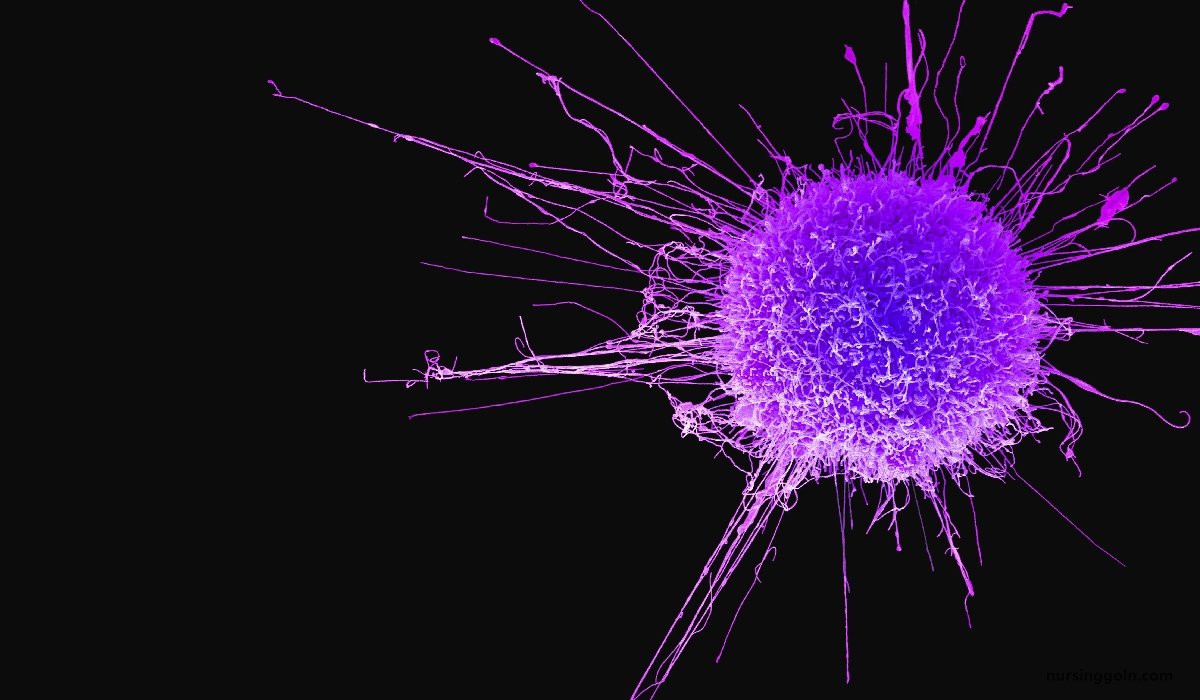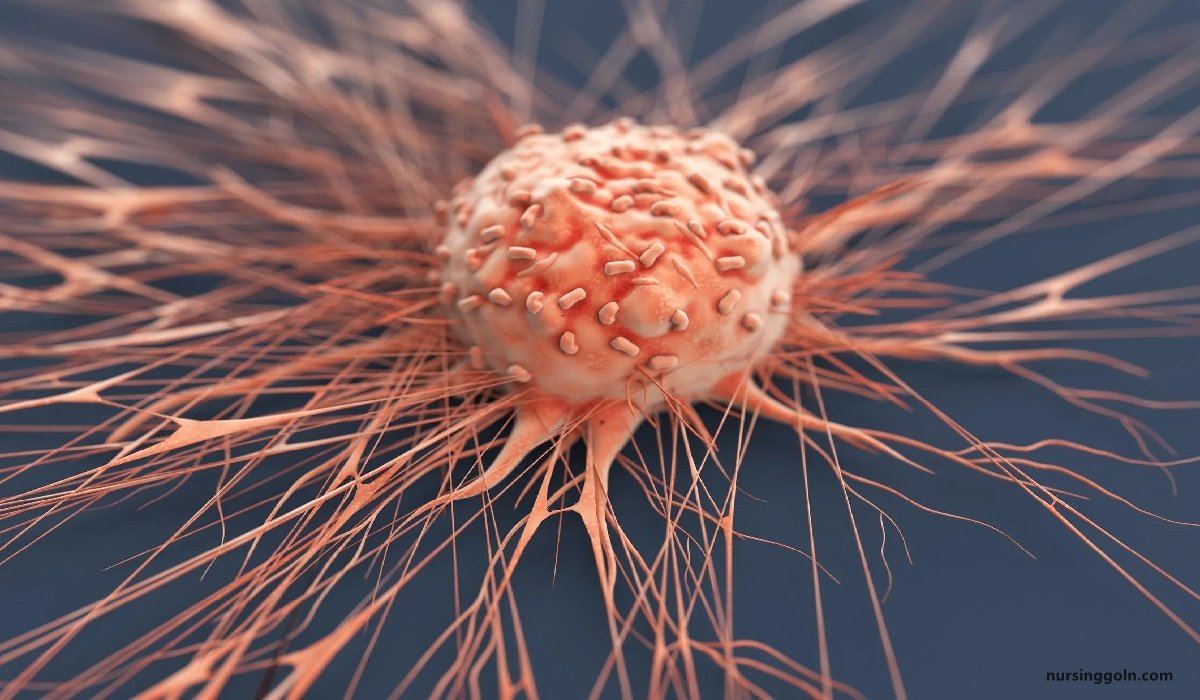Nutritional Management in Cancer – This book covers the entire syllabus of “Nutrition and Dietetics” prescribed by BNMC for all Diploma in Nursing Science and Midwifery students. We tried to accommodate the latest information and topics. This book is an examination-friendly setup according to the teachers’ lectures and examination questions.
At the end of the book previous university questions are given. We hope in touch with the book students’ knowledge will be upgraded and flourish. The unique way of presentation may make your reading of the book a pleasurable experience.

Nutritional Management in Cancer
Cancer is group of more than 100 distinct diseases characterized by the uncontrolled growth of abnormal cells in the body
Or,
Cancer is a group of diseases involving abnormal cell growth with the potential to invade or spread to other parts of the body
Or,
Cancer is a disease process that begins when an abnormal cell is transformed by the genetic mutation of the cellular DNA.
Or,
Cancer is the uncontrolled growth of abnormal cells anywhere in a body. These abnormal cells are termed cancer cells, malignant cells, or tumor cells. These cells can infiltrate normal body tissues.
Definition of Neoplasia:
The term neoplasia refers to a mass that has developed due to abnormal cell or tissue growth. Neoplasia refers to various types of growths including non-cancerous or benign tumors, precancerous growths, carcinoma in situ and malignant or cancerous tumors.
Definition of Neoplasm:
The term neoplasm is derived from a combination of the Greek words “neo” meaning new and “plasma” meaning formation.
One widely used definition of neoplasm is that described by the British oncologist R.A. Willis which stated: “A neoplasm is an abnormal mass of tissue, the growth of which exceeds and is uncoordinated with that of the normal tissues, and persists in the same excessive manner after cessation of the stimulus which evoked the change.”
Definition of Tumors:
Tumors are groups of abnormal cells that form lumps or growths. They can start in any one of the trillions of cells in our bodies. Tumors grow and behave differently, depending on whether they are cancerous (malignant), non-cancerous (benign) or precancerous.
Types of Tumors:
| Benign Tumors/ Non-Cancerous Tumor: | Tumors that aren’t cancerous are called non-cancerous tumors. Non- cancerous tumors:
|
| Premalignant/ Precancerous: | A premalignant tumor is not yet cancerous but appears to be developing the properties of cancer. |
| Malignant tumors /Cancerous Tumor: | Cancer can start in any part of the body. When cancer cells form a lump or growth, it is called a cancerous tumor. A tumor is cancerous when it:
|
Difference between Benign and Malignant Tumor:
| Traits | Benign Tumor | Malignant Tumor |
| Definition | These are not cancerous and cannot spread. A benign tumor will remain in its current form. They do not generally return after being removed. | Malignant tumors are cancerous. They can grow, spread, and get worse. |
| Differentiation /anaplasia | Well differentiated,Structure sometimes typical of tissue of origin | Some lack of differentiation with anaplasia: structure often atypical |
| Rate of growth | Usually progressive an slow: may come to a standstill or regress: mitotic figures rare and normal | Erratic and may be slow to rapid : mitotic figures may be numerous and abnormal |
| Local invasion | Usually cohesive expansile well- demarcated masses that do not invade or infiltrate surrounding normal tissues | Locally invasive, infiltrating surrounding tissue: sometimes may be seemingly cohesive and expansile |
| Metastasis | Absent | Frequently present; the larger and more undifferentiated the primary, the more likely are metastases |
Most Common Types of Benign Tumors
- Adenomas (epithelial tissue that covers the organs and glands)
- Meningiomas (brain and spinal cord)
- Fibromas or fibroids (connective tissue of any organ-most commonly found in the uterus)
- Papillomas (skin, breast, cervix, and mucus membranes)
- Lipomas (fat cells)
- Nevi (moles)
- Myomas (muscle tissue)
- Hemangiomas (blood vessels and skin)
- Neuromas (nerves)
- Osteochondromas (bones) Depending on the location and size of a benign tumor, treatment might not be necessary. Doctors will monitor it, track patient symptoms and do tests at specific intervals.
Types of Malignant Tumor:
1. Carcinoma: begins in the skin or tissues in internal organs
2. Sarcoma: begins in bone, fat, cartilage, muscle, blood vessels or other connective tissues in the body
3. Leukemia: malignancy that begins in bone marrow or other blood-forming tissue, causing abnormal cells to enter the bloodstream
4. Lymphoma and multiple myeloma: begin in cells of the immune system

Ways to spread of malignant tumors:
Invasion and Metastasis of malignant tumors:
- Mechanical pressure exerted by rapidly proliferating neoplasms force fingerlike projections of tumor cells into surrounding tissue and interstitial spaces
- Malignant cells are thought to possess or produce specific destructive enzymes (proteinases), such as collagenases (specific to collagen), plasminogen activators(specific to plasma) and lysosomal hydrolyses
Lymphatic Spread:
- Tumor emboli enter the lymph channels by way of the interstitial fluid, which communicates with lymphatic fluid
- Malignant cells penetrate lymphatic vessels by invasion
- Malignant cells either lodge in the lymph nodes or pass between the lymphatic and venous circulations.
Hematogenous Spread:
- Dissemination of malignant cells via the blood stream and is directly related to the vascularity of the tumor
- Malignant cells attach to endothelium and attract fibrin, platelets, and clotting factors to seal themselves from immune system surveillance
- Malignant cells to enter the basement membrane and secrete lysosomal enzymes.
Warning Signs of Cancer:
According to World Health Organization
| Warning signs | What to look for |
| 1. Unusual bleeding/discharge |
|
| 2. A sore which does not heal | Sores that:
|
| 3. Change in bowel or bladder habits |
|
| 4. Lump in breast or other part of the body |
|
| 5. Nagging cough |
|
| 6. Obvious change in moles | Use the ABCD RULE
|
| 7. Difficulty in swallowing |
|
(Ref by-www.afro.who.int)
Clinical Feature of Cancer:
- The presence of an unusual lump in the body
- Changes in a mole on the skin, such as size, color or shape thickness
- A persistent cough or hoarseness
- A change in bowel habits, such as unusual diarrhea or constipation
- Difficulty in swallowing or continuing indigestion
- Any abnormal bleeding, including bleeding from the vagina, or blood in urine or faeces
- A persistent sore or ulcer
- Difficulty passing urine
- Unexplained weight loss
- Unexplained pain
- Unexplained tiredness or fatigue
- Skin changes such as an unexplained rash or unusual texture
- Unexplained night sweats
- Abdominal pain
Types of Cancer
Cancers can be grouped according to the type of cell they start in. There are 5 main categories
1. Carcinoma cancer that begins in the skin or in tissues that line or cover internal organs. There are a number of subtypes, including adenocarcinoma, basal cell carcinoma, squamous cell carcinoma, and transitional cell carcinoma
2. Sarcoma-cancer that begins in the connective or supportive tissues such as bone, cartilage, fat, muscle, or blood vessels
3. Leukaemia-cancer that starts in blood forming tissue such as the bone marrow and causes large numbers of abnormal blood cells to be produced and go into the blood
4. Lymphoma and myeloma – cancers that begin in the cells of the immune system
5. Brain and spinal cord cancers – these are known as central nervous system cancers
Common Types of Cancer in Bangladesh:
- Lung cancer
- Breast cancer
- Cervical cancer
- Colorectal cancer
- Esophageal cancer
- Skin cancer
- Stomach cancer
- Testicular cancer
- Prostate cancer
Etiology/Causes of Cancer:
1. Environmental factors
a) Tobacco: cancer of the lung, larynx, mouth, pharynx, esophagus, bladder pancreas and probably kidney.
b) Alcohol: esophageal, liver and rectal cancers.
c) Dietary factor:
- Smoked fish is related to stomach cancer.
- Dietary fiber to intestinal cancer
- Beef consumption to bowel cancer and
- High fat to breast cancer
d) Occupational exposure: Exposure to benzene, arsenic, cadmium, chromium, vinyl chloride, asbestos, polycyclic hydrocarbons etc.
e) Viruses:
- Hepatitis B&C: hepatocellular carcinoma.
- HIV infection: Kaposi’s sarcoma, non-Hodgkin’s lymphoma.
- Epstein Barr virus: Burkett’s lymphoma and nasopharyngeal carcinoma.
- Human papilloma virus: cancer of cervix.
f) Parasites: Schistosomiasis: carcinoma of the bladder.
g) Customs habits and life style:
- Smoking: lung cancer
- Tobacco betel chewing: oral cancer
h) Others: sunlight. Radiation, air and water pollution, medications and pesticides.
2. Genetic factors: retinoblastoma occurs in children of the same parent.
(Ref by-K Park/234/385)

Risk Factors of Cancer
According to World Health Organization (WHO), common risk factors for cancer include:
- Tobacco use
- Alcohol use
- Overweight and obesity
- Dietary factors, including insufficient fruit and vegetable intake
- Physical inactivity
- Chronic infections from helicobacter pylori, hepatitis B virus (HBV), hepatitis C virus (HCV) and some types of human papilloma virus (HPV)
- Environmental and occupational risks including ionizing and non-ionizing radiation
Diet Menu For Liver Cancer Patient:
1. Advised to take moderate protein 80 to 100 grams per day” In case of impending coma reduce protein intake.
2. Advised to take 2000 to 3000 kcal per day.
3. Limit sodium and potassium in the diet in case of ascites.
4. Advised to take 1500 ml to 2000 ml per day.
5. Decrease fat intake in case of steatorrhea.
6. Provide vitamin B, C and K, Mineral and iron supplement.
7. Avoid spices, popper, coffee and coarse food.
8. Advised to take small frequent meals.
(Ref: Onila Salin’s Essential nutrition/1/142)
Prevention & Control of Cancer:
It is estimated that at least one-third of all cancer are preventable and another third can be cured through early diagnosis and treatment. So the basic approach to the control of cancer is through primary and secondary prevention.
A. Primary prevention:
The primary preventive efforts are aimed at reducing or eliminating causative environmental, nutritional and other risk factors by taking appropriate measures shown in the following table.
| Cancer | Primary preventive measures |
| Cancer lung and larynx | Control of tobacco (smoking or chewing tobacco). Avoidance of contact with asbestos |
| Cancer breast (female) | Avoidance of obesity and over indulgence in fatty food |
| Cancer penis | Circumcision |
| Melanoma skin | Removal of pigmented naevi subjected to irritation |
| Cancer skin | Avoidance of over-exposure |
| Endometrial cancer | Avoidance of oral contraceptive and use of DES (for menooause). 0 Avoidance of obesity and excess intake of fat. |
| Cancer stomach | Taking of fresh food and fruits |
| Cancer cervix | Avoidance of early marriage, multiple sex partners and multiple pregnancies. Maintenance of cleanliness, genital hygiene. |
| Cancer colon/rectum | Avoidance of fatty food, taking plenty of fruits, vegetables and fibre containing food |
| Cancer oropharynx | Avoidance of smoking and chewing tobacco. Avoidance of alcohol, improvement of oral hygiene |
| Primary liver cancer | Use of hepatitis B virus vaccine. Taking of food without alflatoxin. |
| Cancer esophagus | Avoidance of smoking and alcohol. |
B. Secondary prevention: This comprises the following measures:
1. Cancer registration: Hospital-based and population based.
2. Early detection of cases: By cancer screening at pre invasive (in situ) pre-malignant stage.
3. Treatment by:
- Surgical removal.
- Radiotherapy or chemotherapy or both.
- Relief of cancer pain to those who are beyond the curable stage.
(Ref: K. Park/24th)

Warning Signs (Danger Signals) of Cancer:
Physicians, nurses and other health workers must be aware of the danger signals for cancer which are usually associated with one or another type of cancer. These signals are:
1. Unusual bleeding or discharge from any natural orifices.
2. A lump or thickening of the breast or elsewhere.
3. A sore that does not heal.
4. Change in vowel or bladder habits.
5. Hoarseness or persistent cough.
6. Constant indigestion or difficulty in swallowing.
7. Change in a wart or mole.
(Ref: RKH/5/311)
Risk Factors for Oral Cancer:
1. Tobacco chewing and tobacco smoking.
2. High intake of alcohol.
3. Pre-cancerous lesions e.g. leukoplakia, erythroplakia.
4. High risk groups: These include tobacco chewers and smokers, biri smokers, people using tobacco in other forms such as betel, quid; people who sleep with the tobacco quid in the mouth.
Read more:
